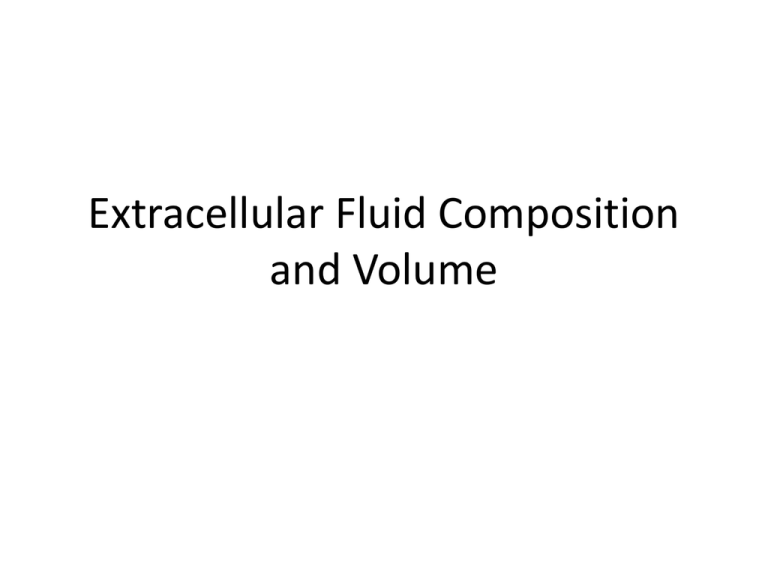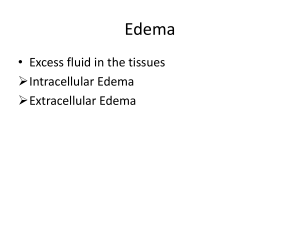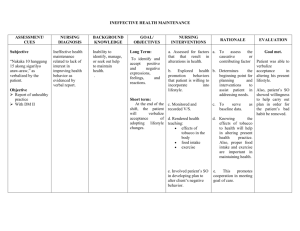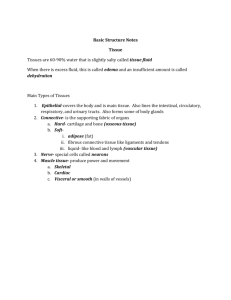Extracellular Fluid Composition and Volume
advertisement

Extracellular Fluid Composition and Volume Learning Objectives • Know the distribution of bodily fluids and composition of intracellular and extracellular fluid. • Know how to calculate the volume of the different fluid compartments. • Know how to calculate the shifts in osmolarity. • Know what causes the 2 types of edema. • Know what mechanisms the body uses to prevent edema. Water Balance The body must maintain a relatively constant volume and composition of the bodily fluids under a wide variety of conditions. Distribution of Bodily Fluids • Most of the H2O is intracellular. • The total body H2O is ~ 60% of the body weight (~ 42 L). • The % depends on age, gender, and degree of obesity. Composition of Intracellular and Extracellular Fluid Note: The intracellular compartment of Ca2+ is very low compared to the extracellular. Ca2+ is a very important signaling molecule for electrical signals and protein activation. Calculating Compartment fluid Volume This works only if the indicator uniformly diffused and only into the measured fluid compartment, and if the indicator itself is not metabolized or excreted. Calculating Total Body Water • Use radioactive water (3H2O) or heavy water (2H2O). • This will mix with the total body water in just a few hours and the dilution method (previous slide) can be used. Determine Extracellular and Intracellular fluid Volume • For extracellular volume, use a substance that does not cross cell membranes, but does pass through capillary pores. - Radioactive insulin is used for this purpose. • Then, calculate intracellular volume from: Intracellular volume = total body water – extracellular volume Plasma and Interstitial Fluid Volume • For plasma volume, use an indicator that does not diffuse across plasma membranes or capillary pores. - 125I-albumin is used for this purpose. • Interstitial fluid volume can then be calculated from: interstitial fluid volume = extracellular fluid volume – plasma volume Measure Blood Volume • Remember, hematocrit can be measured by centrifuging Osmotic Pressure and Osmosis • Chapter 25 reviews some basic concepts of osmosis and osmotic pressure. • You should already know this material, plus, we used it to cover osmotic forces that determine the fluid flow at capillaries. • For cells, remember that H2O passively diffuses across plasma membranes, but not most ions and solutes. Adding Different Osmotic Solutions to the Extracellular Fluid Calculating Shifts in Osmolarity • What happens when 2L of 3% solution of NaCl is added to the extracellular fluid of a 70-kg person, whose initial plasma osmolarity is 280 mOsm/L? • Initially, the total body fluid is 42L, the extracellular fluid is 14L at 280 mOsm/L (3,920 mOsm) and the intracellular fluid is 28L at 280 mOsm/L (7,840 mOsm). • The NaCl added was 2L x 3g/100ml = 60g or 1,026 mol (MW of NaCl = 58.5 g/mol). 1.026 mol NaCl = 2,051 mOsm (1.026 x 2 x 1,000) • Now, the total body fluid is 44L and the extracelular fluid is 16L with 5,971 mOsm at 373 mOsm/L. • Then, the intracellular and extracellular concentrations will equilibrate to 313.9 mOsm/L (13,811 mOsm/44L). • Thus, the extracellular fluid becomes 19.02L (5,971 mOsm/313.9 mOsm/L) and the intracellular fluid becomes 27.98L (7,840 mOsm/313.9 mOsm/L). Edema • Edema is the presence of excess fluid in the body tissues. Broadly, there are 2 types of edema: - Intracellular edema (less common) - Extracellular edema Intracellular Edema • Can be caused by depressed metabolism or inadequate nutrition, such as decreased blood flow. • The membrane pumps become depressed and the cells are unable to pump out the Na+ that leaks in, causing the edema. Extracellular Edema Caused by: Increases in capillary filtration Increase capillary filtration coefficient Increase capillary hydrostatic pressure Decrease plasma osmotic pressure Blockage of lymph flow The net rate of capillary filtration in the entire body is ~ 2ml/min, which is returned to the circulation by the lymphatic system Changes in Capillary Pressures • You should already be familiar with these factors. • Factors that increase capillary hydrostatic pressure: - Excessive retention of salt and H2O - High venous pressure - Decreased arteriolar resistance • Factors that decrease capillary osmotic pressure: - Loss of plasma proteins (in urine, from deamaged skin, failure to produce proteins as occurs in cirrhosis or malnutrition). • Factors that increase capillary permeability: - Immune reactions (histamine release) - Toxins - Burns Lymphatic Blockage • In the body, the mean capillary forces show a net filtration pressure of 0.3 mm Hg, tending to move fluid outward through the capillary pores. • The net rate of filtration in the entire body is ~ 2 ml/min, which is returned to the circulation by the lymphatic system. • Edema that occurs by blockage of the lymphatic can be especially severe, because the lymphatic system returns proteins to the blood that pass through the capillaries. • Thus, in addition to the back-up of fluid, the osmotic pressure of the interstitial fluid increases. Factors that Cause Blockage of Lymph Return • Cancer • Infection (elephatiasis is caused by a mosquito-born filaria worm) • Congenital absence or abnormality of the lymph vessels. Factors that Prevent Edema • Low compliance of the interstitium under normal conditions. • Increased lymph flow. • Washdown of interstitial fluid protein. Interstitium Low Compliance of Interstitium • This is established by the interstitial gel, which is the proteoglycan polymers in the interstitium. • This prevents fluid from flowing easily. • As a result, the addition of extra fluid causes a large incease in interstitial hydrostatic pressure (decreasing capillary filtration rate). • However, too much interstitial fluid creates channels in the gel, increasing the compliance of the interstitium. • Note – the interstitial gel also helps to prevent excessive fluid from flowing to your feet when standing. Low Compliance of Interstitium Increased Lymph Flow • When fluid begins to accumulate in the interstitium, lymph flow can increase 10- to 50-fold. • The increased lymph flow also helps decrease the [interstitial proteins], called “washdown” (see text). • “Washdown” occurs because with increased flow, proteins are removed faster than they filter acrosss the capillaries.



